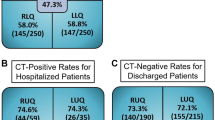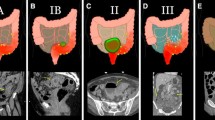Abstract
The purpose of this study is to calculate the negative predictive value (NPV) CT of the abdomen in patients presenting to the emergency department (ED) with undifferentiated upper abdominal pain. Approved by the hospital research ethics board, this retrospective study examined consecutive patients presenting to the ED with undifferentiated upper abdominal pain whose intravenous contrast-enhanced CT of the abdomen was reported as “normal” from June 2006–August 2010. Exclusion criteria included active malignancy, trauma, and known inflammatory bowel disease. True-negative (TN) vs. false-negative (FN) cases were categorized by consensus opinion of radiologist and emergency physician using a composite reference standard including clinical, laboratory, imaging, surgery, pathology, and patient self-reporting via phone questionnaire. The NPV was calculated with confidence intervals of 95%. The TN and FN groups were compared based on gender, age, site of pain, oral contrast use, and laboratory values. One hundred twenty-seven patients were included for analysis. The NPV was 64% (95% CI 55–72). The FN group had a higher proportion of patients with epigastric pain (p = 0.02) and a lower proportion of patients with left upper quadrant pain (p = 0.02). The WBC, lipase, and ALT were all higher in the FN group compared with the TN group. The most commonly missed pathologies were inflammatory conditions of the biliary tract and upper gastrointestinal systems. The NPV of CT for evaluation of undifferentiated upper abdominal pain in the ED was low at 64%. Physicians should consider this limitation and the commonly missed pathology when discharging patients with a “normal” CT report.

Similar content being viewed by others
References
Bhuiya FA, Pitts SR, McCaig LF (2010) Emergency department visits for chest pain and abdominal pain: United States, 1999–2008. NCHS Data Brief 43:1–8
Abujudeh HH, Kaewlai R, McMahon PM et al (2011) Abdominopelvic CT increases diagnostic certainty and guide management decisions: a prospective investigation of 584 patients in a large academic medical center. AJR Am J Roentgenol 196(2):238–243
Larson DB, Johnson LW, Schnell BM, Salisbury SR, Forman HP (2011) National trends in CT use in the emergency department: 1995–2007. Radiology 258(1):164–173
Broder J, Warshauer DM (2006) Increasing utilization of computed tomography in the adult emergency department, 2000–2005. Emerg Radiol 13:25–30
MacKersie AB, Lane MJ, Gerhardt RT et al (2005) Nontraumatic acute abdominal pain: unenhanced helical CT compared with three-view acute abdominal series. Radiology 237(1):114–122
Rosen MP, Sands DZ, Longmaid HE 3rd, Reynolds KF, Wagner M, Raptopoulos V (2000) Impact of abdominal CT on the management of patients presenting to the emergency department with acute abdominal pain. AJR Am J Roentgenol 174:1391–1396
Mun S, Ernst RD, Chen K, Oto A, Shah S, Mileski WJ (2006) Rapid CT diagnosis of acute appendicitis with IV contrast material. Emerg Radiol 12(3):19–102
Tack D, Sourtzis S, Delpierre I, de Maertelaer V, Gevenois PA (2003) Low-dose unenhanced multidetector CT of patients with suspected renal colic. AJR Am J Roentgenol 180(2):305–311
Arvanitakis M, Delhave M, Maertelaere DV et al (2004) Computed tomography and magnetic resonance imaging in the assessment of acute pancreatitis. Gastroenterology 126(3):715–723
Van Randen V, Lameris W, van Es W et al (2011) A comparison of the accuracy of ultrasound and computed tomography in common diagnoses causing acute abdominal pain. Eur Radiol 21:1535–1545
Anderson SW, Rhoe E, Soto JA (2008) Detection of biliary duct narrowing and choledocholithiasis: accuracy of portal venous phase multidetector CT. Radiology 247(2):418–427
Anderson SW, Lucey BC, Varghese JC, Soto JA (2006) Accuracy of MDCT in the diagnosis of choledocholithiasis. Am J Roentgenol 187(1):174–180
Bossuyt PM, Reitsma JB, Bruns DE et al (2003) Towards complete and accurate reporting of studies of diagnostic accuracy: the STARD Initiative. Radiology 226(1):24–28
Barakos JA, Ralls PW, Lapin SA et al (1987) Cholelithiasis: evaluation with CT. Radiology 162:415–418
Sugiyama M, Atomi Y (1997) Endoscopic ultrasonography for diagnosing choledocholithiasis: a prospective comparative study with ultrasonography and computed tomography. Gastrointest Endosc 45(2):143–146
Harvey RT, Miller WT Jr (1999) Acute biliary disease: Initial CT and follow-up US versus initial US and follow-up CT. Radiology 213(3):831–836
Balthazar EJ, Freeny PC, van Sonnenberg E (1994) Imaging and intervention in acute pancreatitis. Radiology 193:297–306
Hill MC, Barkin J, Isikoff MB, Silverstein W, Kalser M (1982) Acute pancreatitis: clinical vs. CT findings. AJR Am J Roentgenol 139(2):263–269
King LR, Siegel MJ, Balfe DM (1995) Acute pancreatitis in children: CT findings of intra- and extrapancreatic fluid collections. Radiology 195(1):196–200
Maher MM, Lucey BC, Gervais DA, Mueller PR (2004) Acute pancreatitis: the role of imaging and interventional radiology. Cardiovasc Intervent Radiol 27:208–225
Siewert B, Raptopoulos V, Mueller MF, Rosen MP, Steer M (1997) Impact of CT on diagnosis and management of the acute abdomen in patients initially treated without surgery. Am J Roentgenol 168(1):173–178
Balthazar EJ (1991) CT of the gastrointestinal tract: principles and interpretation. AJR Am J Roentgenol 156(1):23–32
Macari M, Balthazar EJ (2001) CT of bowel wall thickening: significance and pitfalls of interpretation. AJR Am J Roentgenol 176(5):1105–1116
Lowell M (2006) Esophagus, stomach, and duodenum. In: Marx J, Hockberger R, Walls R et al (eds) Rosen's emergency medicine: concepts and clinical practice, vol 2, 6th edn. Mosby, St. Louis, pp 1390–1394
Kim S, Haruma K, Ito M, Tanaka S, Yoshihara M, Chayama K (2003) Magnifying gastroendoscopy for diagnosis of histologic gastritis in the gastric antrum. Dig Liver Dis 36:286–291
Roth C, Tello R, Sutherland K, Ptak T (2002) Prediction rule for etiology of vague abdominal pain in the emergency room: utility for imaging triage. Invest Radiol 37(10):552–556
Treacy J, Williams A, Bais R et al (2001) Evaluation of amylase and lipase in the diagnosis of acute pancreatitis. ANZ J Surg 71(10):577–582
Lewis LM, Klippel AP, Bavolek RA, Ross LM, Scherer TM, Banet GA (2007) Quantifying the usefulness of CT in evaluating seniors with abdominal pain. Eur J Radiol 61:290–296
Esses D, Birnbaum A, Bijur P et al (2004) Ability of CT to alter decision making in elderly patients with acute abdominal pain. Am J Emerg Med 22:270–272
Coughlin SS (1990) Recall bias in epidemiologic studies. J Clin Epidemiol 43(1):87–91
Altman DG, Bland JM (1994) Statistics notes: diagnostic tests 2: predictive values. BMJ 309:102
Author information
Authors and Affiliations
Corresponding author
Additional information
This study was partially funded by the University of Ottawa Faculty of Medicine summer student research award.
Appendix 1: follow-up telephone questionnaire
Appendix 1: follow-up telephone questionnaire

Rights and permissions
About this article
Cite this article
Ham, H., McInnes, M.D.F., Woo, M. et al. Negative predictive value of intravenous contrast-enhanced CT of the abdomen for patients presenting to the emergency department with undifferentiated upper abdominal pain. Emerg Radiol 19, 19–26 (2012). https://doi.org/10.1007/s10140-011-0996-x
Received:
Accepted:
Published:
Issue Date:
DOI: https://doi.org/10.1007/s10140-011-0996-x




